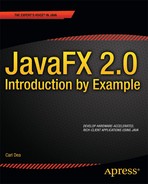Book Description
JavaFX 2.0: Introduction by Example provides a quick start to programming the JavaFX 2.0 platform. JavaFX 2.0 provides a rich set of APIs for use in creating graphically exciting client applications written solely in Java. You get a large set of customizable components that can be skinned using CSS techniques that you already know from doing web development. The platform even includes a web rendering engine enabling you to mix HTML content into your applications. Hardware acceleration means that your applications are fast and snappy, taking full advantage of modern graphics processing support at the hardware level. JavaFX 2.0 opens the door to business applications that look good, are fun to use, that take advantage of the medium to present data of all types—text, audio, video, etc.—in ways that engage the user and lead to increased productivity.
Getting started with JavaFX 2.0 is surprisingly easy. You already have the Java skills. Very likely you know enough of CSS to get by. All that's left is to get a leg up on the API, and that's where JavaFX 2.0: Introduction by Example can help. In this short book, author Carl Dea takes you through a series of engaging, fun-to-work examples that bring you up to speed on the major facets of the platform. Begin with the fundamentals of installing the software and creating a simple interface. Move in progressive steps through the process of developing a working dialog box for an application. Then let the fun begin as you explore images and animations, audio and video, and finally learn to embed JavaFX applications in a web page as well as embedding HTML5 content within an application. At the end of this book you'll have a good grasp of what JavaFX is all about, and you'll be ready to begin your journey towards mastery of the platform.
Entirely example-based
Focused on practical applications
Full of working code for you to adapt and extend
What you'll learn
Install JavaFX 2.0 and configure your environment
Create applcations menus and dialog boxes
Design forms for data entry
Work with images and animations
Embed audio and video into your applications
Deploy JavaFX applications in a browser
Who this book is for
JavaFX 2.0: Introduction by Example is aimed at Java programmers wanting to learn the JavaFX 2.0 platform for designing graphic- and media-rich client applications for the enterprise. Readers should be familiar with Java, and preferably also with the NetBeans Integrated Development Environment.
Table of Contents
- Title
- Contents at a Glance
- Contents
- About the Author
- About the Technical Reviewer
- Acknowledgments
- Introduction
- Chapter 1: JavaFX Fundamentals
- 1-1. Installing Required Software
- 1-2. Creating a Simple User Interface
- 1-3: Drawing Text
- 1-4: Changing Text Fonts
- 1-5. Creating Shapes
- 1-6. Assigning Colors to Objects
- 1-7. Creating Menus
- 1-8. Adding Components to a Layout
- 1-9. Generating Borders
- 1-10. Binding Expressions
- 1-11. Creating and Working with Observable Lists
- 1-12. Generating a Background Process
- 1-13. Associating Keyboard Sequences to Applications
- 1-14. Creating and Working with Tables
- 1-15. Organizing UI with Split Views
- 1-16. Adding Tabs to the UI
- 1-17. Developing a Dialog Box
- Chapter 2: Graphics with JavaFX
- Chapter 3: Media with JavaFX
- Chapter 4: JavaFX on the Web
- Index
